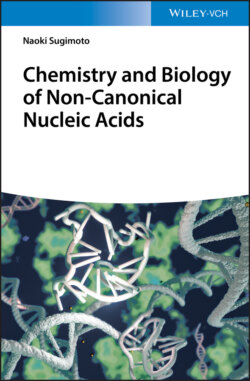Читать книгу Chemistry and Biology of Non-canonical Nucleic Acids - Naoki Sugimoto - Страница 27
2.5 Multi-stranded DNA Helices
ОглавлениеBase paring through hydrogen bonds and stacking interactions between the assembled nucleobases are the main factors that maintain the organized structure of nucleic acids. Multi-stranded structures are formed when nucleobases present in different strands more than three interact with each other to form the assembled structure and stably stack over. Figure 2.7 shows canonical duplex and other typical multi-stranded helices of nucleic acids, in which structures are resisted in protein data bank, including those consisting of unnatural nucleobases.
Among the multi-stranded nucleic acid structures, triplexes and tetraplexes composed of three and four strands, respectively, have been confirmed in not only aqueous solutions but also intracellular conditions and have attracted attention as non-canonical structures that contribute to gene regulations. Various studies have been conducted on the molecular mechanisms of their influence on the gene expressions from viewpoints of their thermodynamic stabilities and conformational dynamics. The structural characteristics and factors that contribute to the thermodynamic stabilities of triplex and representative tetraplexes, G-quadruplex and i-motif, are described in Chapter 3. The effects of these multi-stranded structures on gene expressions are explained in Chapters 5–8, focusing on DNA replication including telomeric regions, RNA transcription, and protein translation.
